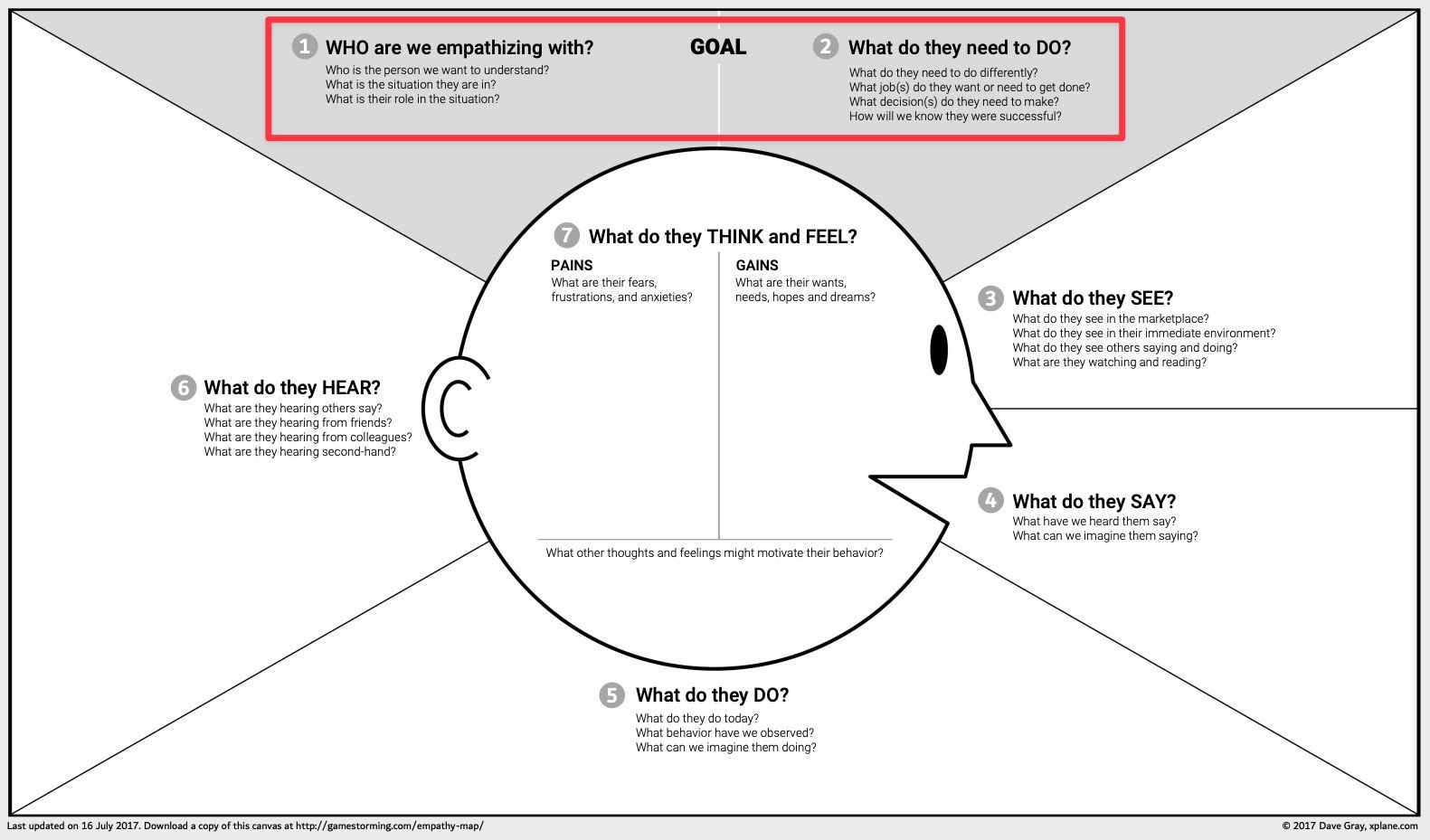Hey friend,
This week, we’re learning how to structure our Sales Safari research using an empathy map.
As empathy mapping aims to get to know our audience on a deep level, we first need to know who and what we’re talking about. That’s what we’ll learn in this lesson:
- How to describe your persona.
- How to clarify your persona’s goals.
The objective of this lesson is to answer the two goal quadrants of the Empathy Map Canvas:

It might seem weird to start with the goal when we don’t know yet what that is. But an empathy map is a living document; it’s a sequence of steps that goes in a circle because we’re supposed to keep iterating.
We'll start with an assumed goal (though we’re better informed after Sales Safari) and adjust as our research progresses.
In this lesson, I give you many prompts. If you’re currently thinking about what audience to serve, then take some time to journal about these questions. But if you’re not ready to organize your Sales Safari research, store this week’s emails for later inspiration.
Still here? Great! Let’s get started with describing a target persona:
Describe your persona
A “persona” is often used in product design and marketing to describe the target audience.
By describing your audience in concrete terms, you make it much easier to know who you’re doing the work for (we humans are visual creatures, after all).
To describe your persona, grab your Sales Safari notes and a dose of creativity as you think about the following questions:
What’s your persona’s name?
Yes, give your target audience a name. Pick one that immediately paints a vivid picture in your mind and motivates you to do the work. Be silly if you want; only you’ll see this.
How old is your persona?
Think of an age range. Don’t fool yourself into thinking your audience is everybody. Different age groups are different personas with unique experiences, challenges, and words to describe both.
What’s your persona’s job?
We’re not working for charity here (well, I’m not). Plus, we want people to have "skin in the game." So, we want to help people solve problems that earn or save them money. That way, they’ll feel good about paying us for our help. Know at least what industry your persona works in, but the more specific you can be, the better.
Where does your persona live?
We’re more connected than ever, but that doesn’t erase our local language or culture. Where your persona lives often also determines how much they can afford to pay you, so be conscious of their geographical location and economic situation.
What groups does your persona identify with?
And because we’re more connected than ever, there are also more identities than ever. Apart from physical traits, what are your persona’s interests and identities? The closer you identify with your persona, the better.
Describe your persona’s goals
By now, you probably see a specific person in your mind (if you’re visual like that). But we can sharpen the picture some more.
Based on your Sales Safari research, you can answer the prompts below in writing. But they’re also great questions to keep in your swipe file for later use in user interviews (something we’ll get to in future courses).
What is their specific goal, and why is it important to them?
We humans are great at learning, but only when we’re motivated. So your first job is to uncover your persona’s goal and why it matters to them. This whole exercise is useless without knowing their why, as we might create something that nobody cares for. For now, write your best hypothesis based on your online detective work.
What are the biggest challenges preventing them from achieving this goal?
We also tend to talk about the things that worry us. For example, the (perceived) obstacles to reaching our goals. Whether real or not, we need to know why our persona worries they might not reach their specific goal.
What have they done in the past to conquer these challenges, and what was the effect?
Most people struggling to reach their goal have already tried multiple solutions. It turns out that most solutions don’t work for most people. We’re unique in our own quirky ways, so we test out different potential solutions. To not waste your persona’s time, know what they’ve already tried without success (and what had some success).
Why did they choose their current approach to achieve this goal?
When people ask for help online, they often share what they’re doing right now. It might not be perfect, but there’s a reason they’re using their current approach over what they’ve tried in the past. We can learn from this and maybe iterate on an existing solution to make it more useful for our persona.
Recap and what’s next
Before you go and answer today’s prompts, here are the key takeaways:
- Paint a vivid picture of your persona. The better you can see your target audience in your mind’s eye, the easier it will be to serve them.
- Consider what your persona wants. After only one week of reading online conversations, knowing precisely what your audience wants is impossible. But it’s always important to start with a hypothesis.
- Know why your persona wants it. To get out of the claws of stale “learning objectives”, we need to know why people care about their goals. So, turn to your Sales Safari notes to uncover why your audience has been struggling to achieve their specific goal.
As these were more writing prompts that I’d like to give in a lesson, I won’t bother you with more. But if you want to share your journal/notes for feedback, I’d love to see a comment or email reply from you.
Tomorrow, we’ll work on the See and Say quadrants of the empathy map. Again, we’ll turn to our Sales Safari notes, so keep “safariing” daily!
—Ramses




